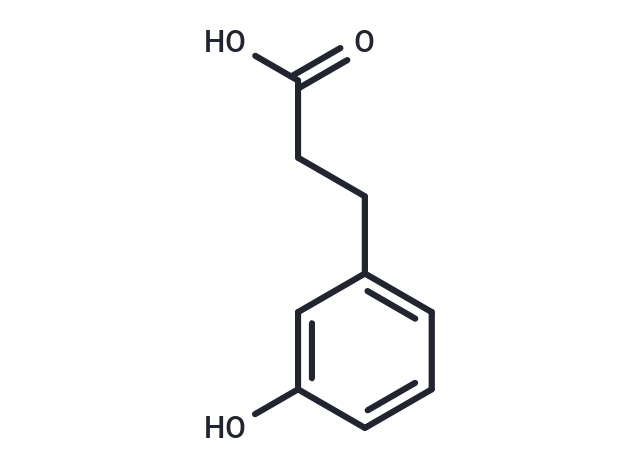Shopping Cart
Remove All Your shopping cart is currently empty
Your shopping cart is currently empty
3-(3-Hydroxyphenyl)propionic Acid (m-Hydroxyphenylpropionic acid) is one of the major metabolites of ingested caffeic acid.it inhibited osteoclastogenesis and bone osteoclastic resorptive activity.

| Pack Size | Price | USA Warehouse | Global Warehouse | Quantity |
|---|---|---|---|---|
| 5 g | $42 | - | In Stock | |
| 10 g | $60 | - | In Stock |
| Description | 3-(3-Hydroxyphenyl)propionic Acid (m-Hydroxyphenylpropionic acid) is one of the major metabolites of ingested caffeic acid.it inhibited osteoclastogenesis and bone osteoclastic resorptive activity. |
| In vitro | 3-(3-hydroxyphenyl) propionic acid (3-3-PPA) and hippuric acid (HA), had dose-dependent suppressive effects on osteoclastogenesis and osteoclast resorptive activity in Corning osteo-assay plates.?Signaling pathway analysis showed that after pretreatment with HA or 3-3-PPA, RANKL-stimulated increase of osteoclastogenic markers, such as nuclear factor of activated T-cells, cytoplasmic 1 and matrix metallopeptidase 9 gene/protein expression were blunted.?Inhibitory effects of HA and 3-3-PPA on osteoclastogenesis utilized RANKL/RANK independent mediators[1]. |
| Cell Research | RAW264.7 cells or nonadherent bone marrow cells were cultured in 96‐well plates (2?×?10^4cells/well) in the presence or absence of 50?ng/ml of RANKL.?Cells were treated with HA at four different concentrations, 0.01×, 0.1×, 1×, and 10×, with 1× equivalent to concentration of 60?μg/dl of HA free form appeared in blood after 10% BB supplemental diet in rats.?Four different concentrations of 3‐3‐PPA or 3‐(4‐hydroxyphenyl) propionic acid (3–4‐PPA), 0.1×, 1×, 10×, and 100×, with 1× equivalent to concentration of 10?μg/dl of 3‐3‐PPA or 3–4‐PPA free form appeared in blood after 10% BB supplemental diet in rats.?After 4 days for RAW264.7 cell cultures and 5 days for bone marrow cell cultures, the cells were ?xed with 4% paraformaldehyde and stained for tartrate‐resistant acid phosphatase (TRAPase) activity using a TRAPase Staining Kit .?TRAP‐positive cells containing >3 nuclei in each well were counted as osteoclasts under an epifluorescent microscope[1] |
| Synonyms | m-Hydroxyphenylpropionic acid, 3-Hydroxyhydrocinnamic acid |
| Molecular Weight | 166.17 |
| Formula | C9H10O3 |
| Cas No. | 621-54-5 |
| Smiles | OC(=O)CCC1=CC=CC(O)=C1 |
| Relative Density. | 1.260 g/cm3 |
| Color | White |
| Appearance | Solid |
| Storage | Powder: -20°C for 3 years | In solvent: -80°C for 1 year | Shipping with blue ice/Shipping at ambient temperature. | |||||||||||||||||||||||||||||||||||
| Solubility Information | DMSO: 100 mg/mL (601.79 mM), Sonication is recommended. | |||||||||||||||||||||||||||||||||||
| In Vivo Formulation | 10% DMSO+40% PEG300+5% Tween 80+45% Saline: 4 mg/mL (24.07 mM), Sonication is recommended. Please add the solvents sequentially, clarifying the solution as much as possible before adding the next one. Dissolve by heating and/or sonication if necessary. Working solution is recommended to be prepared and used immediately. The formulation provided above is for reference purposes only. In vivo formulations may vary and should be modified based on specific experimental conditions. | |||||||||||||||||||||||||||||||||||
Solution Preparation Table | ||||||||||||||||||||||||||||||||||||
DMSO
| ||||||||||||||||||||||||||||||||||||
| Size | Quantity | Unit Price | Amount | Operation |
|---|

Copyright © 2015-2026 TargetMol Chemicals Inc. All Rights Reserved.